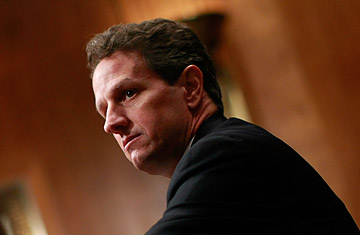
U.S. Treasury Secretary Timothy Geithner
The Administration's long-awaited plan to save America's banks is being delayed again, government sources tell Time. Fears of an AIG-like backlash among potential private investors, and the difficulty of creating a model to price toxic assets on the banks' balance sheets, have both contributed to the delay, the sources say.
The slip is embarrassing for Treasury officials who have been assuring the media and the markets that the plan was coming, first in mid-February, and as recently as March 14 when Treasury Secretary Tim Geithner told Bloomberg TV he would release details soon. A senior Treasury department official says the plan isn't slipping, but other government officials say it is and could be unveiled anywhere from next week to early April. (See TIME's top 25 people to blame for the financial crisis.)
Facing this latest delay, Administration officials are urging patience and insist they are moving more programs on more fronts faster than anyone has tried to do before. "People want a quick, clean, decisive resolution to this stuff, they want us to just fix it and have it be over with," says a senior Administration official. "We are moving in a relatively short period of time on a scale that I don't think you've ever seen an Administration do."
The plan is intended to relieve banks of their toxic assets — including such securities as subprime mortgage bonds — through purchases by a public-private investment fund, heavily backed by government money. But versions of the plan have faced challenges from the start. Last year, when he was head of the New York Federal Reserve, Geithner said the government might to try by itself to restart sales in these assets using a "reverse auction" where sellers bid down an asset's price to compete for buyers. (Read "Obama's Challenge: Containing the AIG Bonus Outrage.")
That plan went nowhere, and in mid-February Geithner announced that the government would design a partnership between private investors and the feds that would kick-start a trading market for the assets. But figuring out what mix of incentives and restraints should be written into the program has proved extremely tricky.
On the one hand, no one wants taxpayer money handed indiscriminately to Wall Street investors with no hope of return. On the other, if the program doesn't encourage buyers to participate not only will the program fail, the markets could suffer a mini-panic, just as they did when the plan was unveiled with no details in mid-February.
Geithner has been burdened by thin staffing as he tries to get nominees to the Senate who can pass muster. In the meantime, he is relying on career staff and a handful of unconfirmed counselors, like Lee Sachs and Gene Sperling, both of whom served in the Clinton administration. (See who's who in Barack Obama's White House.)
Further complicating the challenge, the uproar over AIG has scared potential private investors from any involvement in a government-run program. "AIG makes everything worse," says the senior administration official. Private investors fear that an angry Congress might place restrictions on pay packages for anyone who participates, Treasury, Federal Reserve officials and industry officials say.
In fact, the Federal Reserve had to reassure private investors that they would not be vulnerable to such a backlash when it unveiled a similar government program this week. But that program also had trouble getting off the ground. The Term Asset-Backed Securities Lending Facility, which is designed to spur trading in securitized consumer loans, has gotten off to a slow start, attracting only a handful of applications during the two-day window for participation this week. The total size of the deals fell well-short of the $200 billion the Federal Reserve initially made available for the program, let alone the $1 trillion to which the Fed eventually raised the ceiling.
Geithner and the Obama administration have much stake in the public-private partnership program. It is key to getting banks working again, which makes it an essential element in any economic recovery.
Read "AIG's Distress: Are There Enough Fingers for This Dike?"
